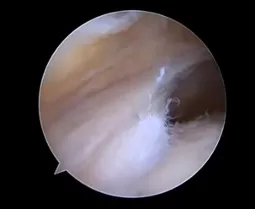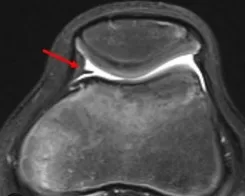Knee Plica Syndrome – An Important Cause of Front Knee Pain
Many patients especially of young age group complain of pain in the front of knee that worsens in stairs, during squat and while getting up from a chair. Often they present with a long history of pain as diagnosis is often missed and effective treatment is not started.
What is knee plica?
A plica is a shelf like membrane or band of thick, fibrotic tissue in the knee joint. When we do knee arthroscopy a normal plica is seen as thin, pink and flexible membrane. Sometimes as a result of overuse (running/riding/ exercising more than usual) or injury, plica can become inflamed due to friction across the patella or the medial femoral condyle. This inflamed plica becomes thickened and it bowstrings over the medial femoral condyle causing pain and swelling in the knee joint.

MRI showing thickened medial plica
Types of plicae in the knee joint:
In the knee, 4 types of plicae can be distinguished, depending on the anatomical location within the knee joint cavities: suprapatellar, medial(inner), infrapatellar and lateral (outer) plicae. The last one is rarely seen and, therefore, there is some controversy regarding its existence or its exact nature.
The medial plica is found between the infrapatellar fat pad and the medial aspect of the knee joint. Medial plicae are the most common type of plicae and are the most common to be symptomatic. This is why pain on the inner side of front of the knee is most common symptom.
Signs and Symptoms and Diagnosis of Plica Syndrome:
Front knee pain is the hallmark of the plica syndrome. A thickened and inflamed plica by rubbing over femoral condyle and patella may give rise to locking, giving way or catching sensation. Pain may be worse during night or walking up or down stairs. It often hurts most squat, bend, or get up after you sit for a long time.
Studies suggest that if not treated, the friction between a medial plica and the medial femoral condyle may lead to cartilage damage. So one should not ignore the front knee pain as early treatment can prevent disabling cartilage damage.
Diagnosis: On clinical suspicion MRI can be done to confirm the diagnosis.

MRI showing thickened medial plica
Treatment of Plica Syndrome
This problem can be easily treated by arthroscopic excision of the plica. From next day of the surgery you can walk again without pain caused by plica.
ABOUT THE AUTHOR

TESTIMONIAL

मेरा दाए पैर में चोट लगने के कारण टेढ़ा हो गया था जिसकी वजह से मुझे चलने में भी परेशानी हो रही थी. डॉ जितेश ने ऑपरेशन कर के इसे सीधा किया. में बिलकुल ठीक हूँ .

मेरी बेटी के घुटने में इन्फेक्शन होने के कारण वो दर्द की वजह से सो भी नहीं पाती थी. डॉ जितेश ने ऑपरेशन कर के इसे ठीक किया. बहुत धन्यवाद।

I remember that Dr. Jain came out from his clinic to see my mother because my mother was not able walk a single step. He did total knee replacement on both side and now my mother is walking without aid.
OPENING HOURS
| Monday – Friday | 17:00 – 20:00 |
| Sunday | OFF |
